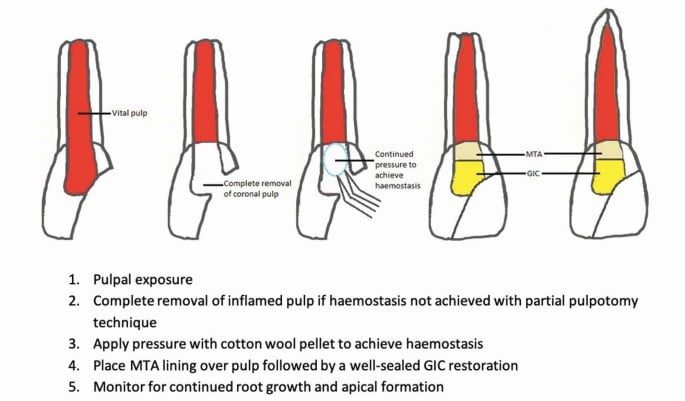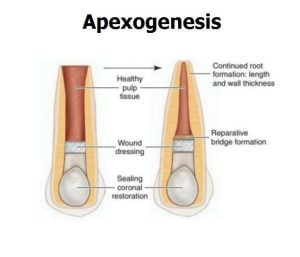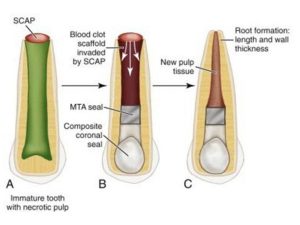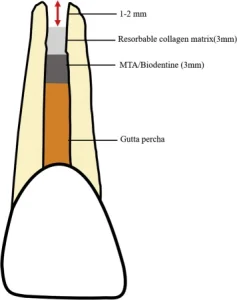Treatment Of Immature (Open Apex) Tooth:
Assistant Professor Dr. Ahmad is a consultant Operative dentist & Endodontist and is expert in vital pulp therapy and regenerative endodontics. Caries and trauma in immature tooth (open apex) results in infection of pulp and periapical area and stopping root development. In immature tooth, RCT is not possible because irrigation solution and obturating material passes beyond the apical foramen. Vital Pulp Therapy, Regenerative Endodontics and Apexification are procedures used to manage open apex. Calcium hydroxide, MTA and biodentine are biocompatible materials used in this therapy.
Vital pulp Therapy and Regenerative Endodontics:

Tooth has outer hard part (enamel, dentin) and inner soft part (pulp). Pulp is important part of tooth. It consists of blood vessels, nerves, cells and matrix. Pulp provides the nutrition, protection and sensation to tooth. In immature (young) tooth, pulp is responsible for tooth root development and maturation.
Vital Pulp Therapy: Vital pulp therapy are procedures to preserve pulp health and save tooth alive(vital) instead of RCT where tooth is saved nonvital. Vital Pulp Therapy include indirect pulp capping, direct pulp caping, partial and complete pulpotomy. Calcium Hydroxide and MTA are used in vital pulp therapy. In mature tooth, Vital Pulp Therapy like indirect pulp caping, direct pulp caping and partial pulpotomy used after caries and trauma that endanger pulp health. Severity of pulp damage, cause of pulp damage (caries, trauma), nature of pain, sensibility (vitality) of tooth, patient’s age and radiographic findings are main factors in making final decision to treat tooth with vital pulp therapy or RCT. In young immature tooth, Vital Pulp Therapy is preferred because it preserves pulp health and promotes growth of root known as apexogenesis.

REGENERATIVE ENDODONTICS:
Regenerative endodontics is a procedure to establish revasculerization (vitality ) of tooth .In necrotic immatre tooth with apical foramen greater then 1mm ,regenerative endodontics is procedure of choice.In necrotic immature tooth ,if tooth gets infected then root development is stopped . RCT is not possible because immature tooth (open apical foramen ) has no apical stop so irrigation material and root filling material (gutta percha) passes beyond th apical formen and damages periapical area.In such cases,regenerative endodontics is a procedure of choice .
Regenerative endodontics procedure:
First visit : After local anaesthesia ,ruber dam is applied and access cavity is prepared .Root canals are disinfected with sodium hypocholoride irrigation and calcium hydroxide dressing for 15 days .
Second visit after 2 weeks : If tooth still having pain and signs of infection ,first visit procedure is repeated . If tooth is pain free and no sign of infection then EDTA irrigation is done to release grown factors from root canal .After saline irrigation , bleeding is induced from periapical area with help of H-fle carried into perapical area. Root canal is filled with blood and collagen membrane is placed in coronal one third of canal and MTA is compacted against collagen membrane .Follow up done after 3 months ,6 months and then each year .Success is measured by primary ,secondary and tertiary success .

Primary success : Patient is pain free with no signs and symptoms of diseae like swelling ,sinus tract etc.Radiographically there is healing of periapical lession .
Secondary success: Incresed in tooth root leghth and width . .It may take 2 to 3 year .
Tertiary success : Regain of tooth vitality with positive response to electric pulp testing and cold test.
APEXIFICATION:
In immature tooth (open apex ), nonvital tooth with apical foramen less then 1 mm ,apexification is procedure of choice . Apexification create apical barrier against which obturation (root filling material ) is done to prevent extrusion of material into periapical area .
Type of apexification:
There are two types of apexification : Calcium Hydroxide Apexification and MTA apexification .Initial canal disinfection is done by sodium hypochlorite irrigation with little instrumentation and calcium hydroxide dressing for 15 days .
In calcium hrdoxide apexification ,calcium hydroxide thick dressing is placed inside root canal to promote apical barrier formation .This may take 3 to 9 month and may make tooth brittle due to long term calcium hydroxide dressing .After apical barrier formation ,root filling(obturation )is done .
In MTA apexification ,artificial MTA apical barries (plug) is created against which obturation is done .This is a 2 visit procedure that can be completed within 2 ,3 days so more preferable .


